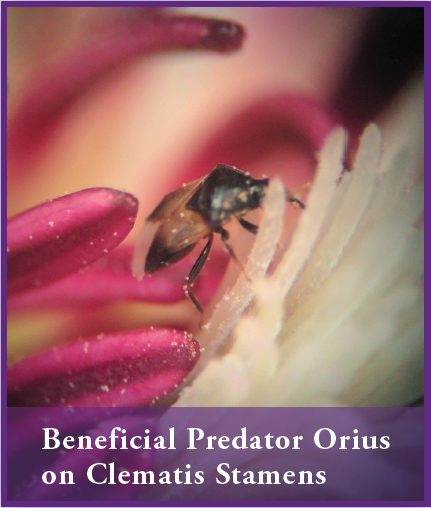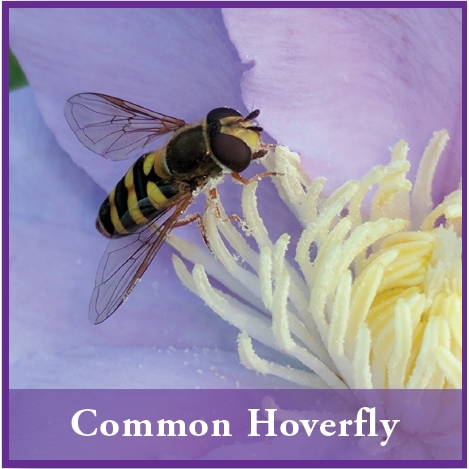Diseases & Pests
Once clematis become well established, they become incredibly robust plants. Although young plants are more susceptible to pest and disease problems, most problems are usually related to improper care. Not providing enough drainage or over watering are primary causes of disease and nutritional problems. Overwatering occurs when watering is done too frequently rather than using too much volume during each watering. Watering should be done thoroughly when the soil is dry.
Garden Bugs
It’s important to realize that most bugs are good bugs. Many insects are predatory or parasitic and defend plants from herbivory insects. Saprophytic insects break down dead plant tissues, that would otherwise rot, and recycle them into nutrients that can be taken up through plant roots. Insects also play a crucial role in pollination, which aid in the production of fruits, flowers and seeds. Soil dwelling insects increase the fertility of soil by leaving droppings, while also improving soil structure by tunneling pathways which also provide aeration.
Distorted growth is often caused by feeding during a leaf ’s early development. Clematis are very vigorous and can grow out of many insect and disease problems very quickly. Check whether the insect pest is still there and if beneficial insects have already begun to help. The colourful clematis flowers do well at attracting beneficial, natural predators like Orius, a very common, voracious, predator that preys on many common pests.
Slugs are the most common pest problem to affect clematis, particularly with young or newly planted clematis because their leaves are easily accessible to slugs near the ground. Slugs prefer to attack young shoots, thus slug bait early in the spring gives the best results. To be sure that it is slugs, look early in the morning or late in the evening while they are not hiding from the sun’s heat, or you can look for slug slime.
Slug damage may occasionally be confused with that of the black vine weevil. However, black vine weevils leave D shaped notches on the margins of the leaves only, whereas, slug damage can take any shape and occur anywhere on the leaf. Black vine weevils, like earwigs, are active at night and go mostly unnoticed. Earwigs may attack in mid-summer and can turn the bloom of a late flowering clematis into a lace work over night. There are many good pesticides and traps available to control earwigs.
For both weevils and earwigs, you can make a pitfall trap by digging a cup into the ground around the infected clematis. This can help control the adults as well ensure the identity of the culprit. The destructive nature of Caterpillars is similar to slugs or black vine weevil but can be distinguished by the pellet like droppings left behind. Spraying Bacillus thuringiensis is a safe and effective treatment.
One of the most common type of insects on clematis are Leafhopper. Their modified hind legs allow them to jump exceedingly well. They are often seen flying around in great numbers. Translucent exoskeletal remains left on the leaves are the key identification tool. Leaf hoppers can scratch up the leaves a bit but are not too much to worry about.
Earwigs may attack in mid-summer and can turn the bloom of a late flowering clematis into a lace work over night. There are many good pesticides and traps available to control earwigs.
Aphids usually feed on the new growth of clematis and often tarnish leaves with their sticky excrement called “honeydew”. Ants will feed on this honeydew and in exchange, provide aphids a piggyback transportation service around the plant. Ants can also protect aphids against their natural enemies (predators). For these reasons it can be helpful to control your ants before trying to control your aphids. The most common natural enemies of aphids found in the garden are tiny parasitoid wasps. A parasitoid wasp uses an ovipositor to inject its eggs inside an aphids’ body. Check to see whether aphids have become parasitized, and begun to turn brown and hard. If so, the aphid population is likely decreasing quickly.
If insect pests get out of control, thoroughly spraying horticultural oils or soaps multiple times a few days apart will provide good control. Soaps and horticultural oils work by suffocating insect populations and leave no residue toxic to beneficial insects. Due to the repeated exposure of insect pests to synthetic pesticides many insect species have developed an incredible resistance to these chemicals. Many synthetic pesticides leave toxic residues that will deter beneficial insects from interacting with the plant. For these reasons we do not recommend the use of synthetic pesticides.

Diseases
Most fungal problems are due to overwatering or not having good drainage in the soil. To test your drainage before planting you can pour a bucket of water in your planting hole. If the water remains standing in the hole for several hours it’s an indication of inadequate drainage. In this case either an alternate planting spot or an amendment to the soil is recommended
The slender and light-weighted form of the clematis is well adapted for climbing. However, special care is needed when supporting or moving a clematis. A bad fall can result in broken stems and provide a target for a wide range of fungi to attack, sometimes causing the plant to wilt. This malady happens most often when the plant is young. “Clematis wilt” is the catch phrase that has developed to describe this occurrence.
Clematis wilt, or Phoma clematidina (formerly known as Ascochyta clematidina) is by far the most common cause of clematis wilt, but not always the culprit. Other pathogens such as Phytophthora cactorum have been shown to cause wilt. Clematis wilt can occur at any time, however it usually happens just as the flower buds begin to open.
The whole plant can be affected or as most often happens, only one or two of the stems collapse. If clematis wilt occurs, it is important to remove and destroy the affected stems. The fungus will remain in the healthy looking part of the stem, so it’s also imperative that about one inch (2.5 cm) of the stem below the infection be removed. New shoots will soon appear at or below the soil line. At worst, pruning will delay your flowering.

P. clematidina is capable of infecting healthy leaves and stems as well as reproducing on dead plant material and on some common weeds. Cleaning up leaf litter and weeds can significantly reduce the source of inoculum. Relatively new studies show that P. clematidina can also infect roots causing a black root rot. Fungicide sprays and drenches can be effective. Daconil and Banner Maxx are fungicides available to the public effective for controlling P. clematidina in the USA. Daconil is available to the public in Canada. The inclusion of mycorrhiza (beneficial fungi) can outcompete or attack plant pathogenic fungi (bad fungi), as well as improve soil structure, and help plants absorb nutrients.
Clematis wilt rarely affects smaller flowered species such as, alpina, cirrosa, macropetela, montana and viticella. Hybrids that have resulted from viticella crosses such as Madame Julia Correvon and Etoile Violette have proved to be very resistant to this affliction.
Another fungus that might affect your clematis is mildew. It is seldom a problem until late in the season and usually not a problem with good air circulation. If mildew is noticed in its early stages it can be easily controlled by many different fungicides readily available. Sometimes clematis can get fungal leaf spots in the fall before dormancy. These fungal pathogens are typically not plant parasitic. Rather, they are more often saprophytic, decomposing leaves that the plant is removing by abscission (shedding) in preparation for winter

